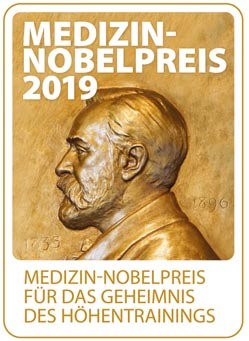The treatment
Hypoxia therapy -
The altitude training (IHHT) for
regeneration of cells
for exhaustion and more
One of the main causes of physically induced exhaustion lies in our cells. If their work is impaired, this results, for example, in metabolic disorders, physical fatigue and even burnout phenomena. A promising method for revitalizing our "cellular power plants" is called hypoxia training. It is based on a cellular mechanism that was awarded the Nobel Prize in Medicine in 2019 for its discovery. At revitCells, we are now able to offer this state-of-the-art therapy.
What is hypoxia training?
Every cell has numerous mitochondria - the power plants of the cell. They normally supply the "petrol" (ATP) that powers the cell. However, laboratory chemistry studies show that illness or unhealthy physical and psychological influences in everyday life damage the mitochondria so that they cannot perform at full capacity. Burnout or chronic exhaustion are prominent examples of this.
In interval hypoxia-hyperoxia training (IHHT), or "altitude training", cells are now stimulated by oxygen regulation to reject damaged mitochondria and replace them with new, healthy ones, so that the cell can once again run at "full power" to increase cell health and cell productivity.
What are the effects of hypoxia training, or altitude training?
Studies have shown that hypoxia training, or altitude training, has positive effects on cell health. High-altitude training is therefore regarded as a newly discovered treatment method for increasing performance, but also for the prevention and treatment of e.g. coronary heart disease, high blood pressure, metabolic disorders, or also exhaustion phenomena such as burnout.
In addition to the regeneration process of the mitochondria, other positive effects on health were observed, such as the formation of new, small blood vessels or the prevention of adhesion of blood components in the vessels.
For the proof and description of the cellular mechanism underlying hypoxia training, the scientists and doctors involved were awarded the Nobel Prize in Medicine in 2019. The basic principle of the training was originally developed for pilots and cosmonauts, but is increasingly used in the treatment of degenerative diseases due to its positive stimulation of numerous bodily functions, which has been proven in many studies.
As feedback, patients often report having a new performance capacity in everyday life. They often mention things like "climbing stairs is much better again," "I have much more energy for my grandchildren," "I get up in the morning completely different, fresh and full of energy," or "my mental resilience has increased enormously.

Lack of strength, burnout and co. - for whom is hypoxia training suitable?
Hypoxia training is suitable for patients who often feel tired and exhausted. It is aimed at all those who experience symptoms of exhaustion, for example as a result of a permanently high stress level, sleep disorders or illness, or who may not be able to identify a direct cause. In many of these cases, it is the impaired mitochondria in our cells that cause the (sometimes severe) symptoms of exhaustion (CFS, burnout).
But a whole range of other diseases also originate in the mitochondria. These include allergies, autoimmune diseases, bronchial asthma, high blood pressure, chronic bronchitis, depressive moods, type II diabetes, hormone disorders, migraine, susceptibility to infections, headaches, sleep disorders and obesity.
How does IHHT treatment work?
One interval hypoxia-hyperoxia training session lasts approximately 40 minutes. As a rule, 20-30 sessions should be performed over a period of 6-12 weeks. Using a state-of-the-art device, during these sessions the patient's oxygen supply is regulated or lowered and raised (in intervals) in a controlled manner via a breathing mask. The training basically simulates breathing as if standing on the Himalayas, in a controlled and targeted manner. The consciously induced lack of oxygen, the so-called hypoxia, is registered by the cells, which sets in motion the processes described above within the cells.
The intensity and the execution of the treatment are adjusted to the patient in advance. For this purpose, various parameters, such as the patient's hypoxia sensitivity, are examined with technical means and blood analyses in order to achieve the optimum treatment.
To increase the effectiveness and depending on the blood analysis, we at revitCells can supplement the IHHT treatment with a course of micronutrients, amino acids, vitamins, etc. - completely individualized and administered intravenously if necessary.
Holistic therapy
In revitCells, I follow a holistic approach in all therapeutic procedures. Especially chronic diseases often have their origin in the intestine. For the first time it is now possible to perform highly complex analyses of the small intestine (not the large intestine!) - in the case of pathological conditions of the microbiota, appropriate treatments can then be carried out. In this case, applications with postbiotics as well as metabolism-regulating and cell-renewing supplementary therapies are recommended, as is possible with hypoxia training. Further therapies of an often unrecognized shift of the fatty acid ratio omega 6/3 are also an integral part of the holistic approach.
In any case, so-called multimodal therapies, i.e. the interaction of several treatments, are more effective than implementing just one single therapy.
Scientific analysis with SF36 questionnaire
To enable you and me to objectively record the success of treatment, each patient receives a questionnaire to be completed digitally, which enjoys international recognition. This Short Form (36) health questionnaire is a disease-unspecific measurement instrument for surveying health-related quality of life. The SF-36 is frequently used in medicine for therapy monitoring or progress measurement. My patients receive the questionnaire before and after completion of therapy.
More information
Hypoxia training explained
Everything at a glance - in this explanatory film by the German company CELLAIR you will see a very clear summary of the function and effects of hypoxia training, as well as the body mechanisms that underlie this treatment.
Get advice on the new IHHT therapy, hypoxia training.
Make an appointment at my revitCells® practice clinic and get detailed advice on the modern techniques for the best possible results.
Arrange appointment




